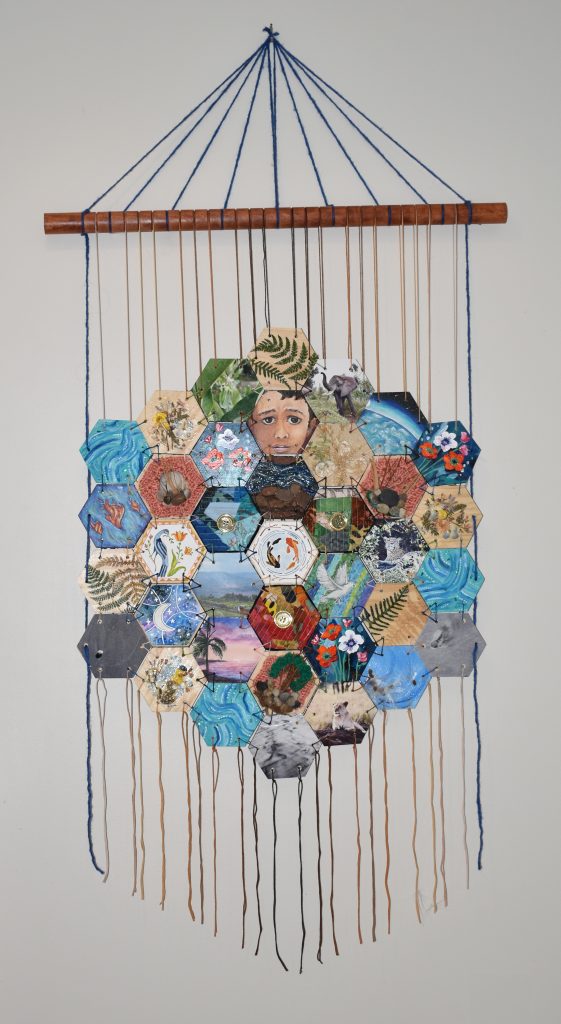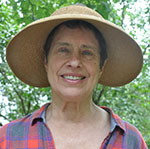by Joyce Munro

immersive and collaborative
An art installation of 12 Mosaic Conference artists suggests its theme: “Creation is Calling for Peace.” It is on display until September 28 at the Conference-Related Ministry Mennonite Heritage Center (Harleysville, PA), along with paintings and worship sanctuary art by Berdine Leinbach (Souderton [PA] congregation).
Ever since she visited Wonderspaces in Austin, TX, Leinbach has wanted to create an interactive multi-sensory art experience. How could she do that for her upcoming 2024 show at the Mennonite Heritage Center? In the Lapp gallery?
Ouisi, a game of associations, has a nature version that invites players to find patterns. “Everyone can notice, wonder, and connect,” Leinbach says about this game. The show idea grew to include the game, as well as an I-spy element.
Another question for Leinbach was: Could artists together create something around a creation theme?
The Interdependence Hexagon Project, an arts and educators collective based in Scranton, PA, uses this geometric shape to focus its makers on relationships that can be made visible and practiced in a world where shared values are needed if we are to survive.
Joy and Connection. These were Leinbach’s longings for the anticipated show. There it was—a hexagon project for Mosaic artists. With six equal sides to connect to other hexagons!

“Berdine asked if I’d be willing to collaborate in this project. I agreed without hesitation,” writes Ramona Pickett (7 Ways Home Fellowship), a liturgical dancer and life coach living in Maryland, with whom Berdine first brainstormed the project.
Leinbach and Pickett had worked together on the intercultural planning team for the October 2022 Mosaic Women’s Gathering. “I knew she was full of ideas and her creative outlet was dance and sewing,” Leinbach says. They brainstormed other artists they knew.
“Carla Garder was the first person who popped into my brain,” Ramona says. Carla and she worship together with 7 Ways Home Fellowship. So the project got a crochet enthusiast.
Glenn Bauman, Joanna Rosenberger, Kim Bergey, Libby Musselman, Lydia Sensenig, Mandy Martin, Tim Swartz, and Vicki Beyer were also on board.
So was Steve, Berdine’s husband and a graphic artist whose skills would be needed when it came to building a visual key for the installation with statements from the artists.
When the hexagons came back from the artists five months later, Berdine saw that no mammals were included (think Edward Hicks’ “The Peaceable Kingdom”). Steve searched through his photos. A lion, elephant, and a leopard made hexagonal entrances.
fusion, sometimes drama
Many individual hexagons speak for themselves:
Dramatic three-dimensional blues and white swirl on Vicki Beyer’s hexagons, sometimes in interlocking patterns. There’s tension and action here.
Poppies like shooting red and white stars pop—these are the flowers of Flanders and war; the artist Mandy Martin reminds viewers—not simply a signature subject of hers.
Subtle green tones and patterns occur in the quilted fabrics of Pickett’s earth hexagon; a gold button for the precious metal that Proverbs signifies is the result of purification provides continuity among her three hexagons.
A child looks at you, its brow furrowed, so that peering at the installation, you cannot help but feel that a trauma has occurred and you are here to wait for its voicing.
counterpoint
Several hexagons benefit from their placement among others:
A crescent moon among distant stars situates questions that night skies prompt, that religions seek to answer. . . abuts Fraktur symbols of Mennonite piety in Kim Bergey’s hexagons.
A grey so dark so close you must make of the scene something that’s almost terrifyingly your own meaning, even though your brain scrambles to categorize the image calmly. . . It is the breakdown of life carbon and mineral that up close is a sandy shore on a cloudy day. Tim Swartz attends to the turmoil narrative of creative process while finding calm in the patterns that happen where land and water meet.
I left the art installation feeling its silences:
the tiny pollinators that get mistakenly called “bees,”
unseen, the billions in a tablespoon of healthy soil and their absence in unhealthy soil,
the vulture gut and its glorious work,
edible oyster fungi growing on dead ash trees,
invisible methane escaping confined meat animals. . .
Then there is the vanilla bean that we are about to lose because of climate change.
What are life changes we could make if we would hear these creations calling for peace?
The collaborative work by Mosaic artists, along with many other of Leinbach’s paintings, are available for viewing at the Mennonite Heritage Center until Sept. 28, 2024.
A photo of this collaborative work was selected by the Hexagon Project’s Posters for Peace exhibit beginning at ArtWorks Gallery and Studio in Scranton from Sept 6-21. It is one of 40 selections out of 1,500 entries.
If your congregation or Conference-Related Ministry is interested in displaying the piece after the exhibit, please let Berdine Leinbach know.
Mosaic congregations and Conference-Related Ministries represented include Souderton Mennonite, Dock Mennonite Academy, Ambler [PA], Blooming Glen [PA] Mennonite, 7 Ways Home Fellowship, and Salford (Harleysville, PA) Mennonite.


Joyce Munro
Joyce Munro is a member of Unami Friends Meeting and involved with the Carbon Forest Project. She is also a volunteer for the Mennonite Heritage Center (Harleysville, PA).
